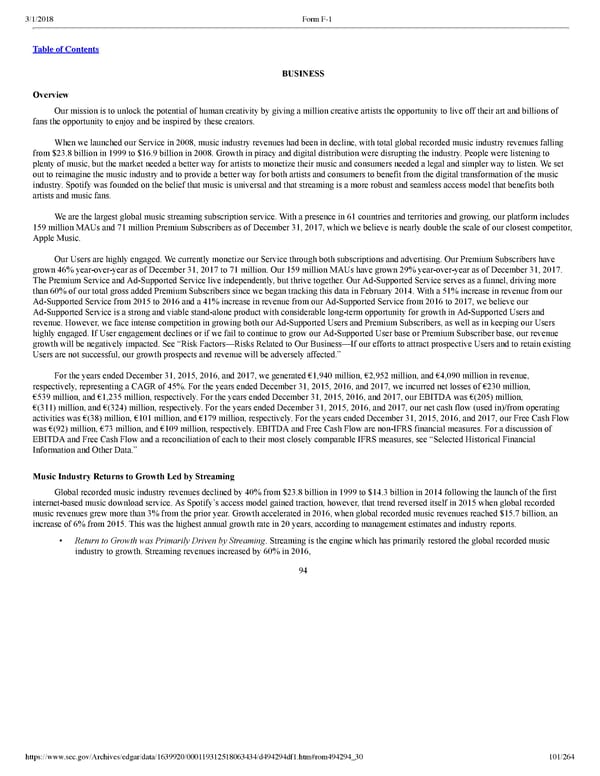101/264 BUSINESS Overview Our mission is to unlock the potential of human creativity by giving a million creative artists the opportunity to live off their art and billions of fans the opportunity to enjoy and be inspired by these creators. When we launched our Service in 2008, music industry revenues had been in decline, with total global recorded music industry revenues falling from $23.8 billion in 1999 to $16.9 billion in 2008. Growth in piracy and digital distribution were disrupting the industry. People were listening to plenty of music, but the market needed a better way for artists to monetize their music and consumers needed a legal and simpler way to listen. We set out to reimagine the music industry and to provide a better way for both artists and consumers to benefit from the digital transformation of the music industry. Spotify was founded on the belief that music is universal and that streaming is a more robust and seamless access model that benefits both artists and music fans. We are the largest global music streaming subscription service. With a presence in 61 countries and territories and growing, our platform includes 159 million MAUs and 71 million Premium Subscribers as of December 31, 2017, which we believe is nearly double the scale of our closest competitor, Apple Music. Our Users are highly engaged. We currently monetize our Service through both subscriptions and advertising. Our Premium Subscribers have grown 46% yearoveryear as of December 31, 2017 to 71 million. Our 159 million MAUs have grown 29% yearoveryear as of December 31, 2017. The Premium Service and AdSupported Service live independently, but thrive together. Our AdSupported Service serves as a funnel, driving more than 60% of our total gross added Premium Subscribers since we began tracking this data in February 2014. With a 51% increase in revenue from our AdSupported Service from 2015 to 2016 and a 41% increase in revenue from our AdSupported Service from 2016 to 2017, we believe our AdSupported Service is a strong and viable standalone product with considerable longterm opportunity for growth in AdSupported Users and revenue. However, we face intense competition in growing both our AdSupported Users and Premium Subscribers, as well as in keeping our Users highly engaged. If User engagement declines or if we fail to continue to grow our AdSupported User base or Premium Subscriber base, our revenue growth will be negatively impacted. See “Risk Factors—Risks Related to Our Business—If our efforts to attract prospective Users and to retain existing Users are not successful, our growth prospects and revenue will be adversely affected.” For the years ended December 31, 2015, 2016, and 2017, we generated €1,940 million, €2,952 million, and €4,090 million in revenue, respectively, representing a CAGR of 45%. For the years ended December 31, 2015, 2016, and 2017, we incurred net losses of €230 million, €539 million, and €1,235 million, respectively. For the years ended December 31, 2015, 2016, and 2017, our EBITDA was €(205) million, €(311) million, and €(324) million, respectively. For the years ended December 31, 2015, 2016, and 2017, our net cash flow (used in)/from operating activities was €(38) million, €101 million, and €179 million, respectively. For the years ended December 31, 2015, 2016, and 2017, our Free Cash Flow was €(92) million, €73 million, and €109 million, respectively. EBITDA and Free Cash Flow are nonIFRS financial measures. For a discussion of EBITDA and Free Cash Flow and a reconciliation of each to their most closely comparable IFRS measures, see “Selected Historical Financial Information and Other Data.” Music Industry Returns to Growth Led by Streaming Global recorded music industry revenues declined by 40% from $23.8 billion in 1999 to $14.3 billion in 2014 following the launch of the first internetbased music download service. As Spotify’s access model gained traction, however, that trend reversed itself in 2015 when global recorded music revenues grew more than 3% from the prior year. Growth accelerated in 2016, when global recorded music revenues reached $15.7 billion, an increase of 6% from 2015. This was the highest annual growth rate in 20 years, according to management estimates and industry reports. • Return to Growth was Primarily Driven by Streaming . Streaming is the engine which has primarily restored the global recorded music industry to growth. Streaming revenues increased by 60% in 2016, 94
 Spotify F1 | Interactive Prospectus Page 100 Page 102
Spotify F1 | Interactive Prospectus Page 100 Page 102